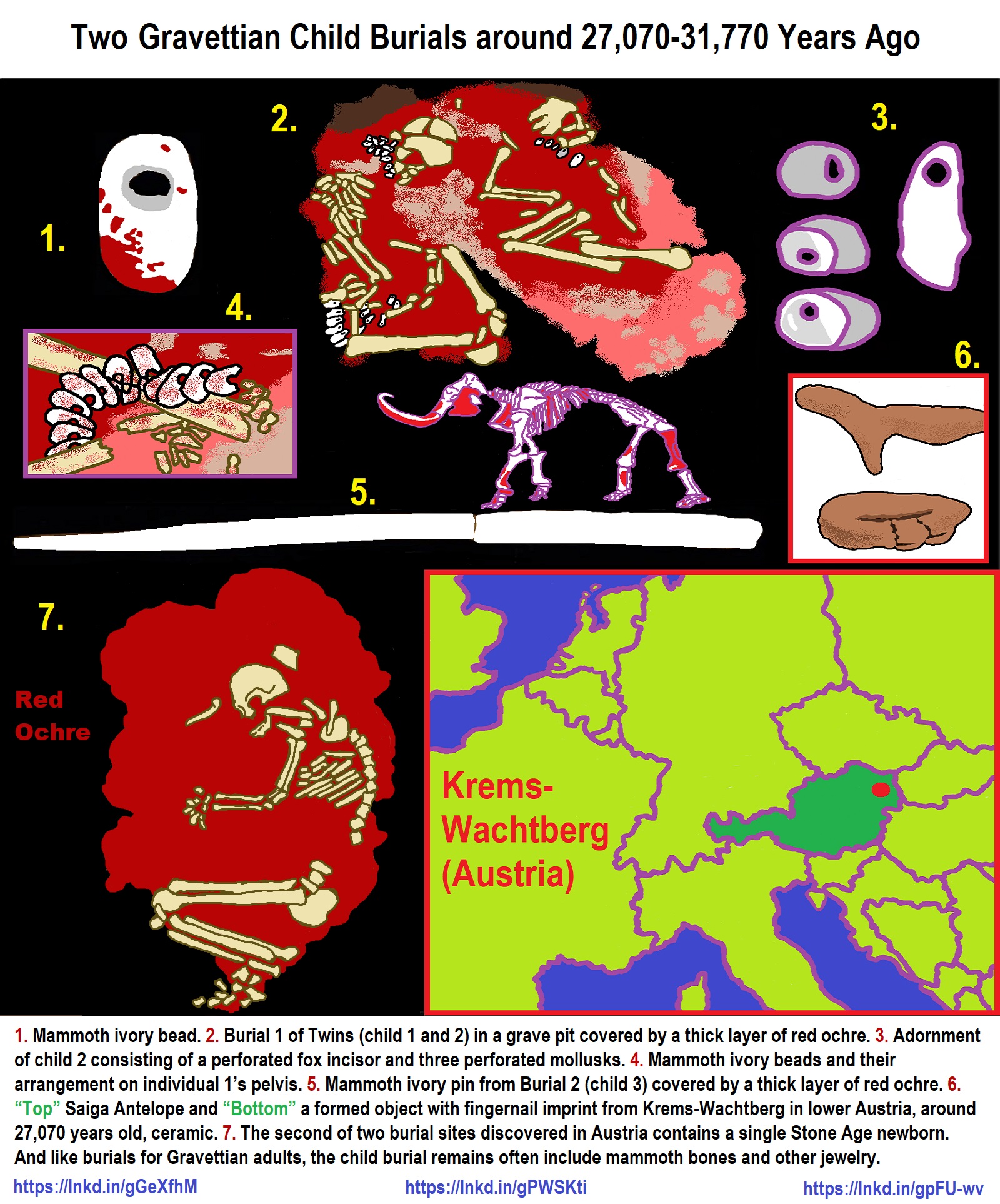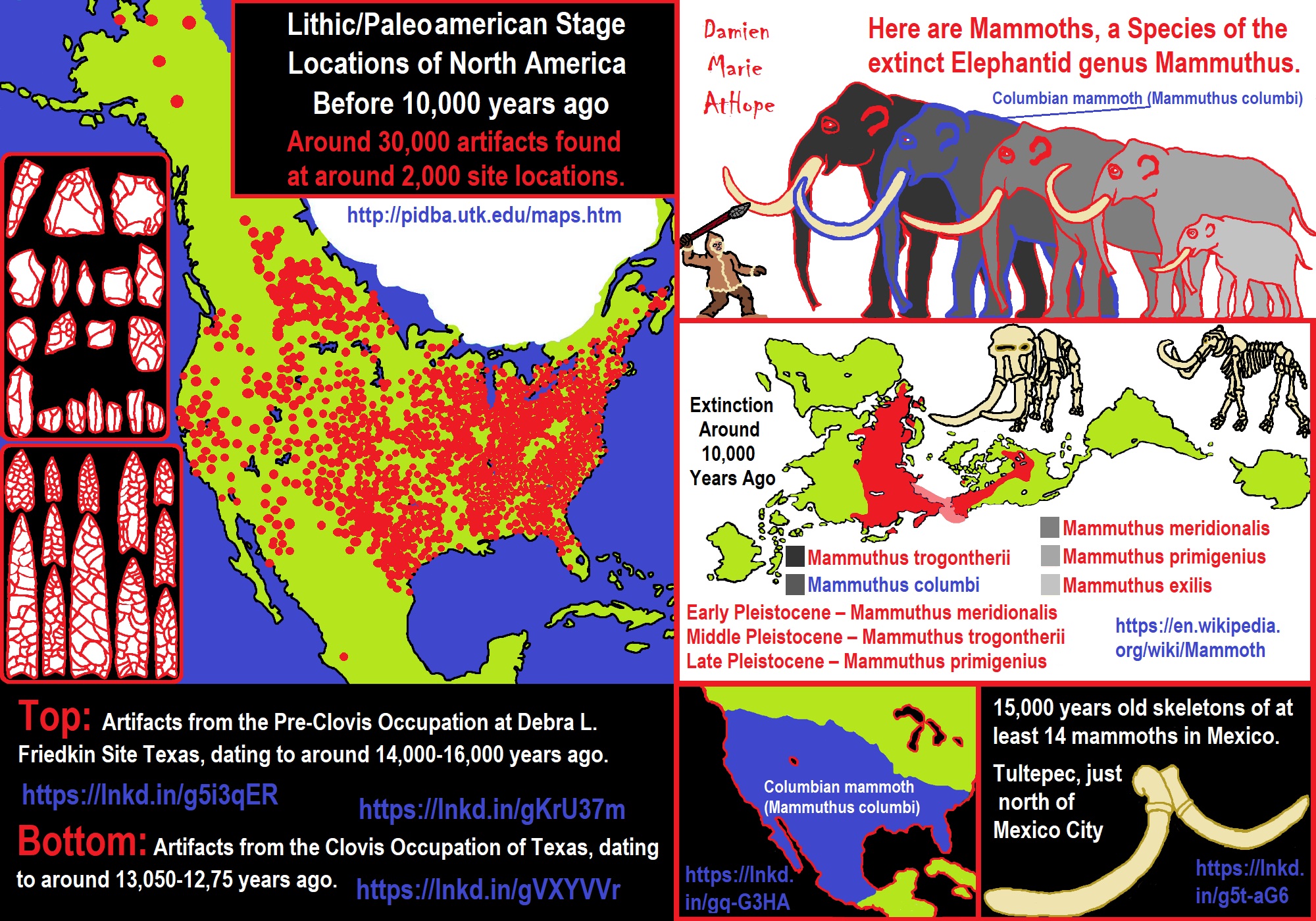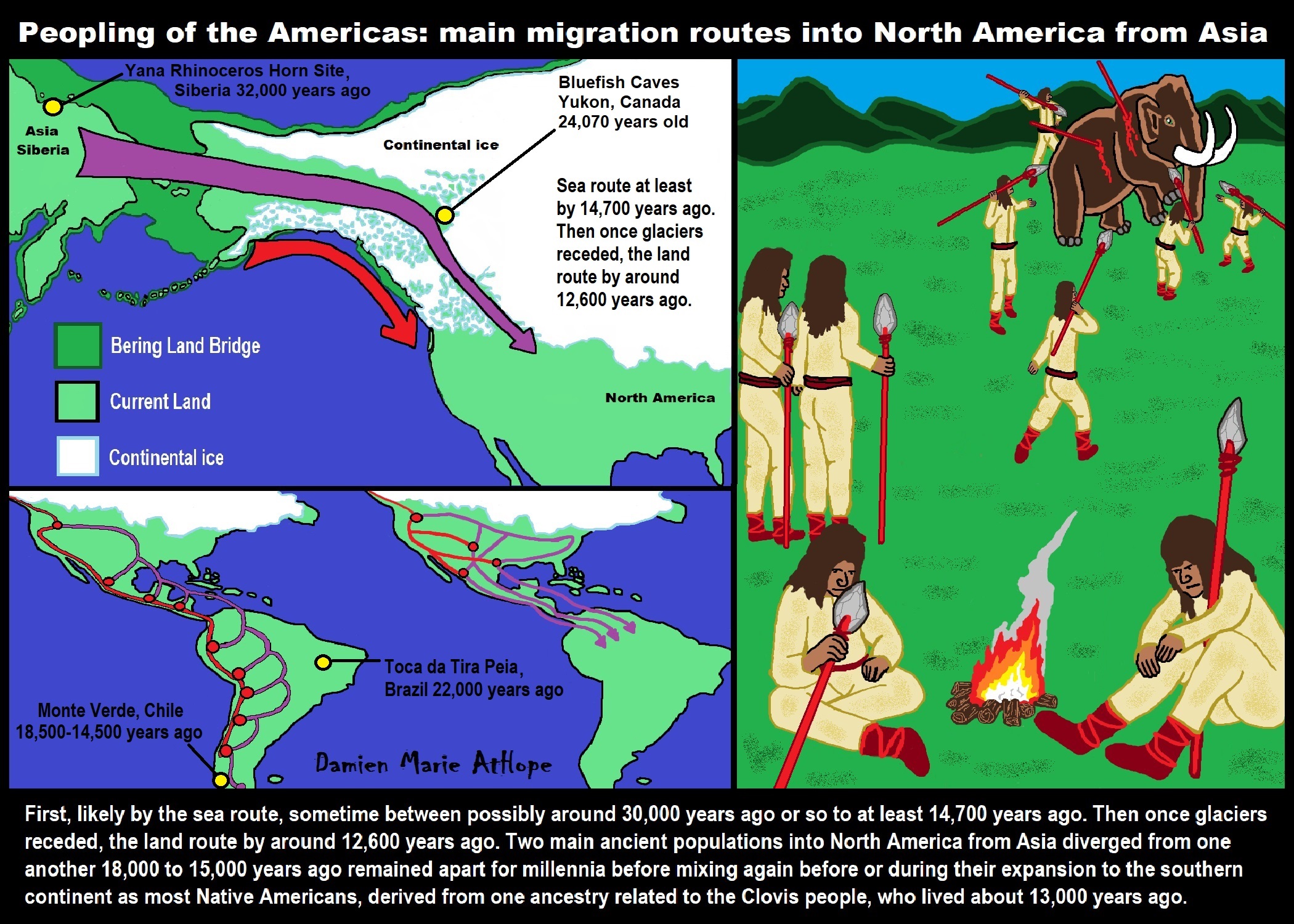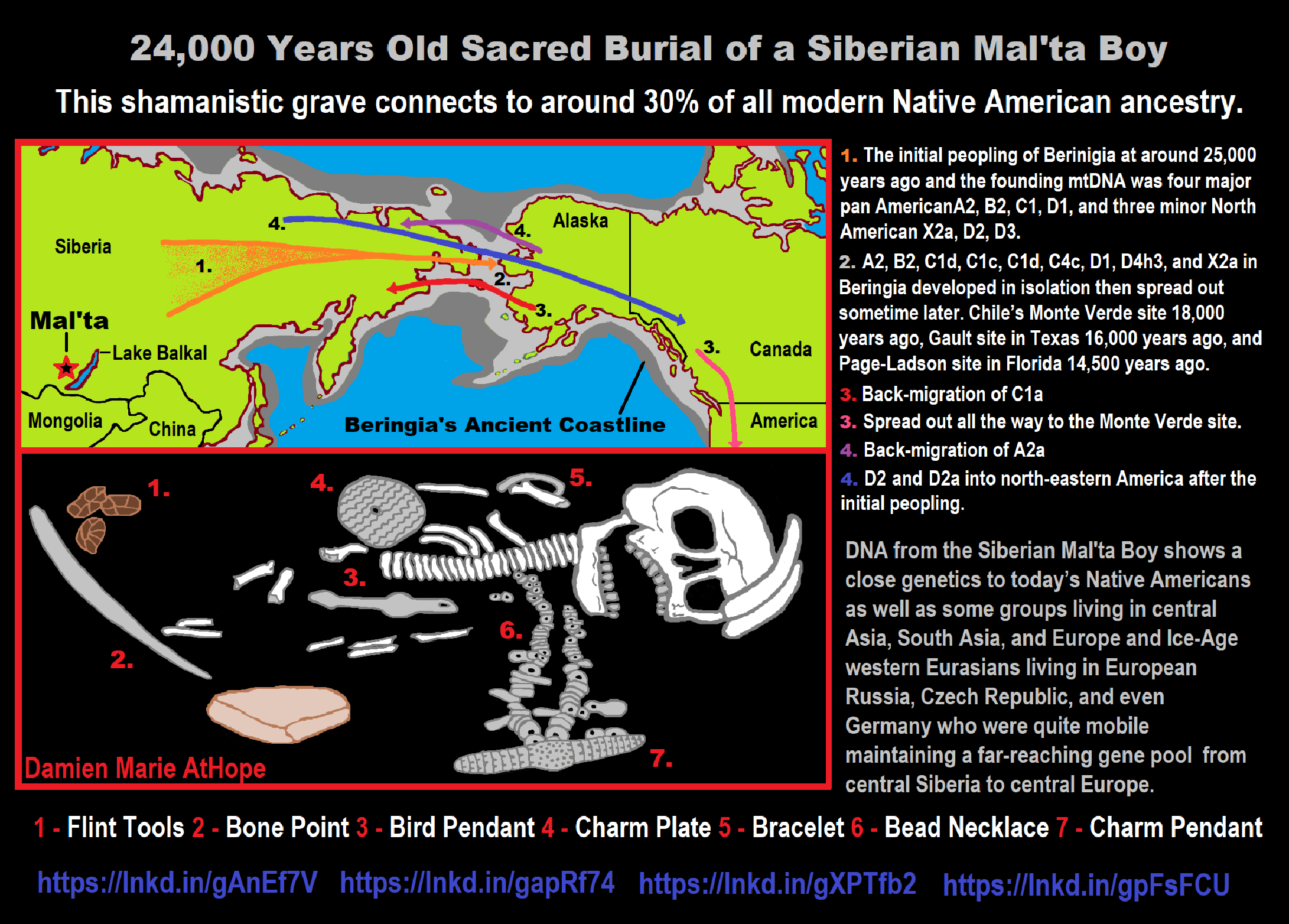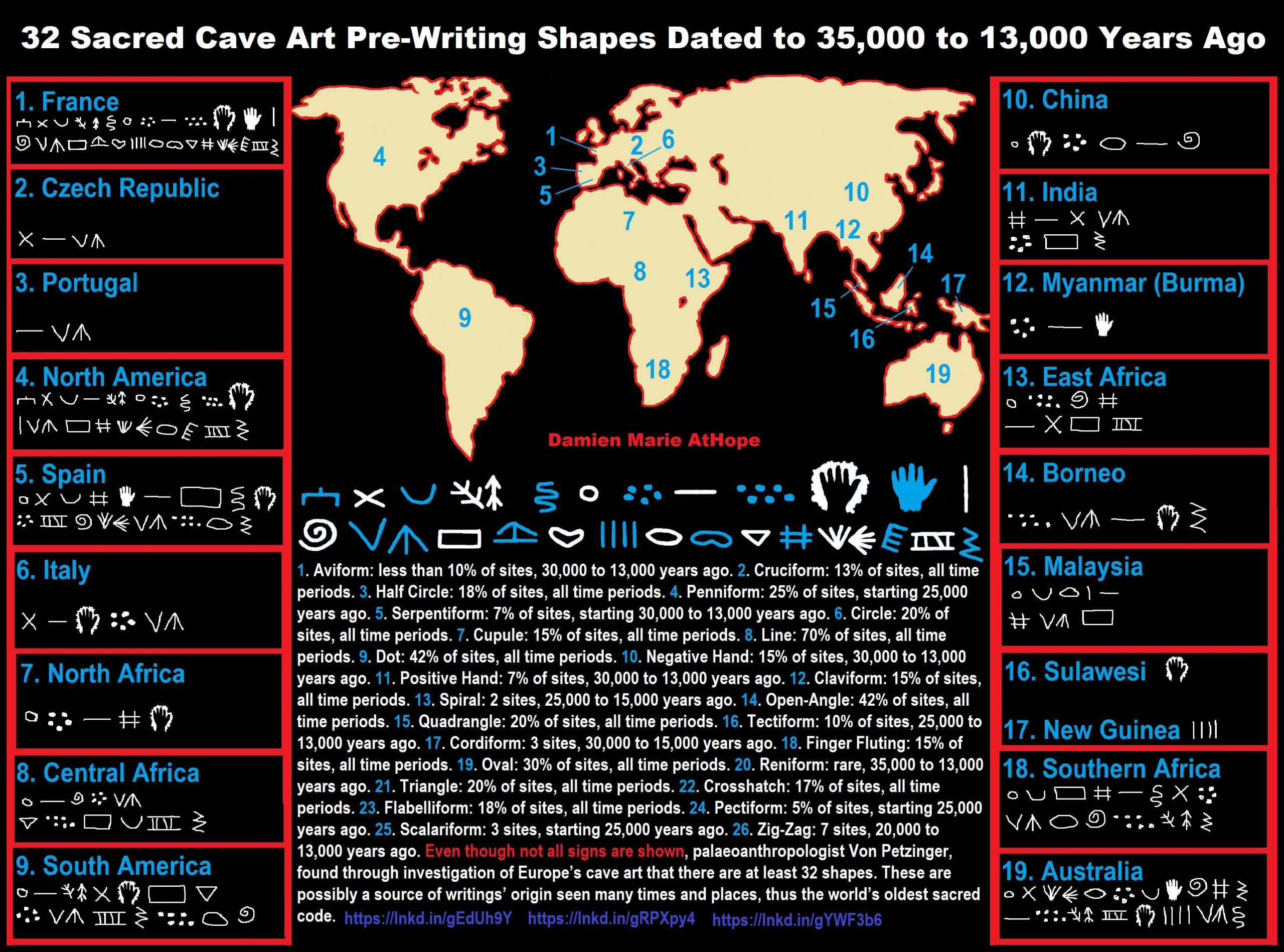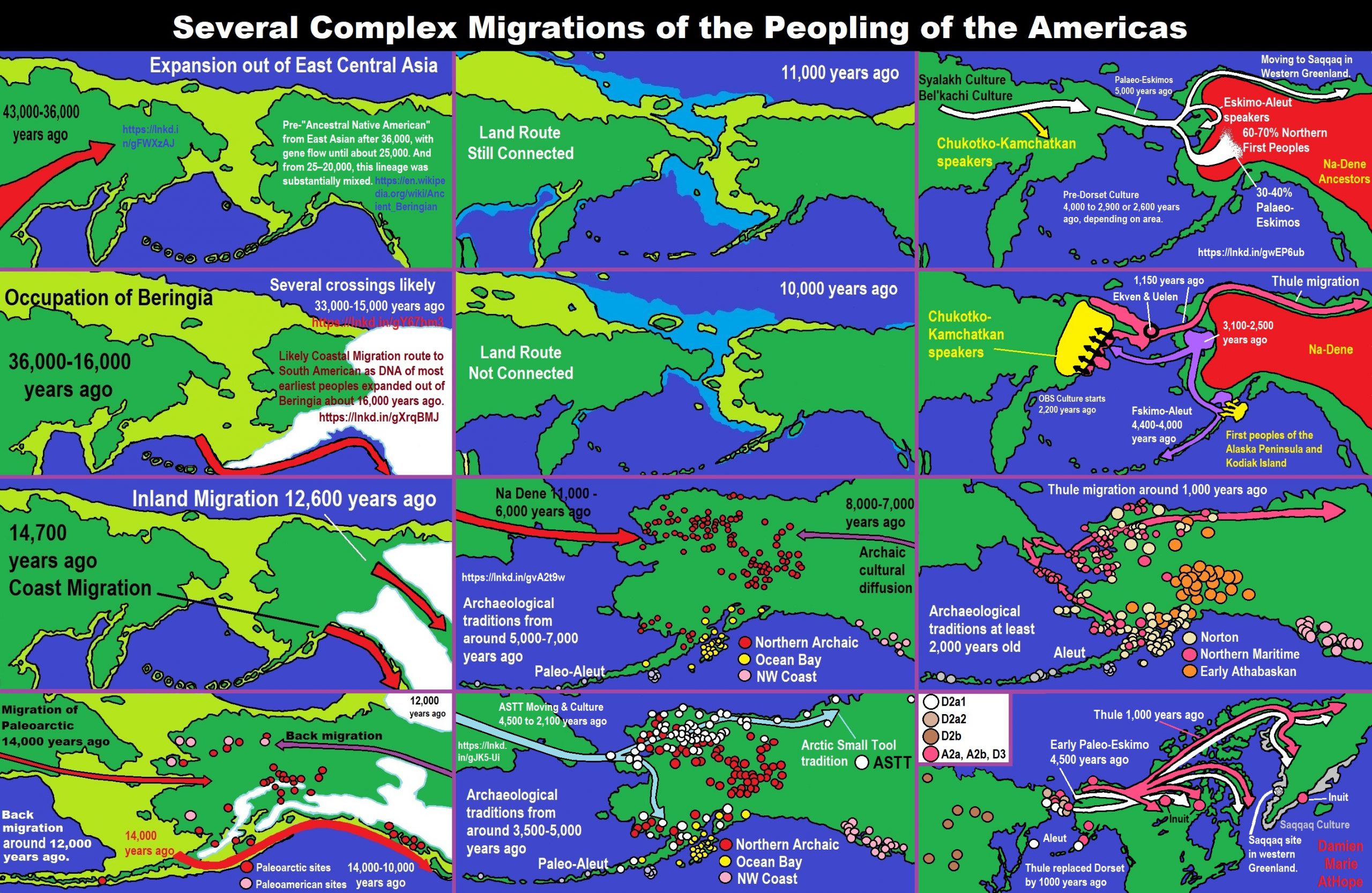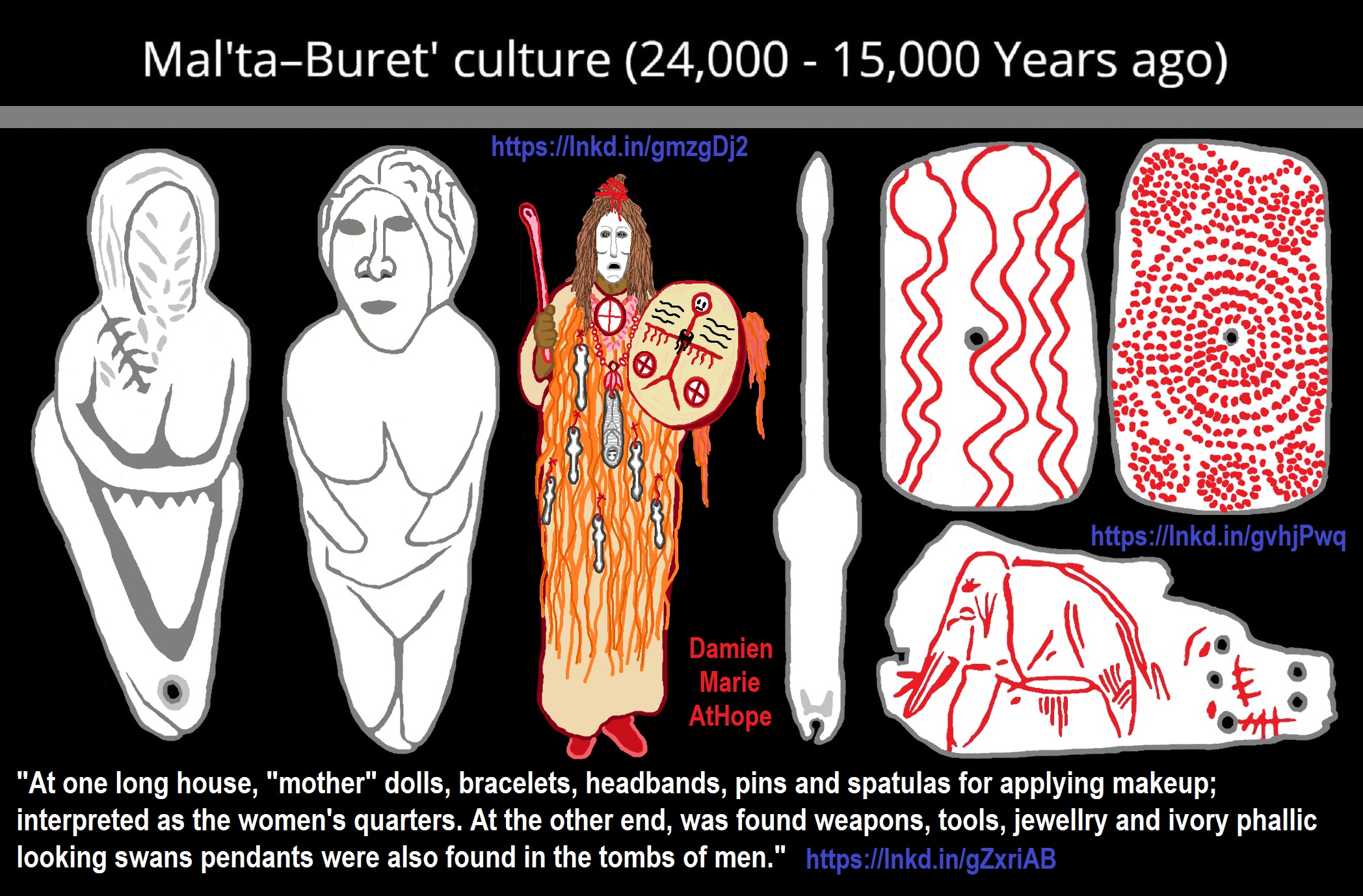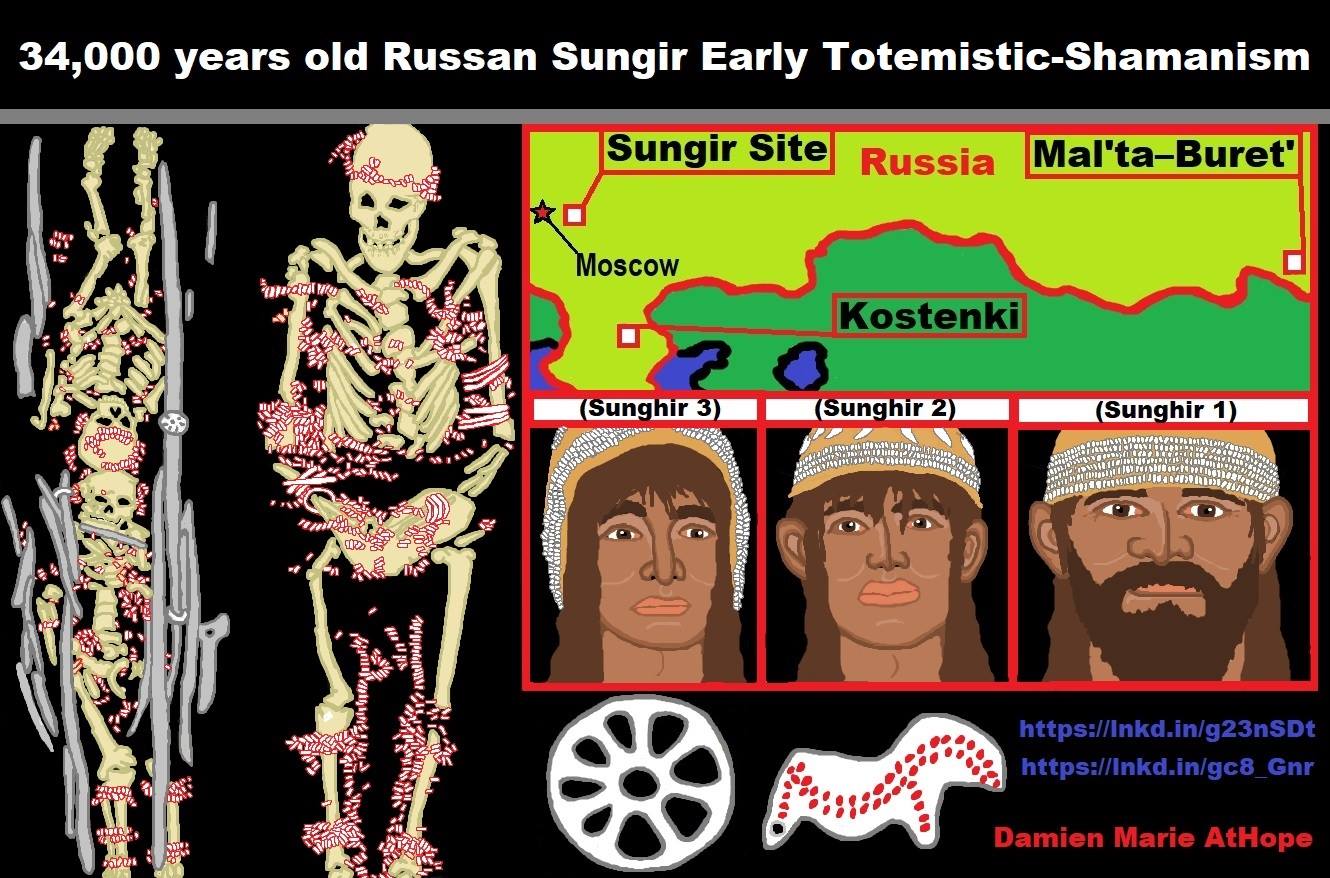
ref, ref, ref, ref, ref, ref, ref, ref, ref, ref, ref
“Probably occupied from as much as around 38,900–32,630 years ago. It had previously been dated at a lower date as low as around 23,000-19,000 years ago which changed.” ref
Sungar “Gravettian culture” (Russia) and related Dolni Vestonice Pavlovian/Gravettian culture (Czech Republic).
Sungar (Russia), found posable evidence of shamanistic Gravettian culture burials and that seem to match the latter indigenous American shamanistic burials in Alaska at the Tanana River site with around 11,500 years old duel infant burial very similar shamanistic grave offerings like decorated stone weapons. To further a clear connection is the Bluefish Cave (Yukon Territory Canada) that held bones with cut marks which is possibly as old as 24,000 to 19,650 years ago and the youngest are around 12,000 years old seem to offer strong support for the “Beringian hypothesis” human population dispersed to North and South America. ref
To me, is seems Siberian is the general origin of native Americans at least by around 11,000 years ago, by the land bridge “Beringia” from Asia by way of Siberia in Russia over to Alaska in the Americas, which the Paleoindians had crossover on, finally flooded over by rising sea levels and was submerged. Siberia has a large variety of climate, vegetation, and landscape. Siberia’s Prehistory demonstrates several distinct cultures sometimes transferring ideas, other times not, and some split from earlier cultures creating new ones often in illation, mainly starting with hunter-gatherer nomadism. During glaciation around 115,000 to 15,000 years ago, the Siberia tundra extended south and an ice sheet covered area of Russia around the Ural Mountains that while some of the oldest mountains are more like large hills, and the area to the east of the lower Yenisei River basin, which in the general area of central and southern Siberia. ref
Some of the first nomadic peoples entered Siberia about 50,000 years ago. Ancient nomadic tribes such as the Ket people and the Yugh people a separate but similar group lived along its banks. Shamanism among Kets shares characteristics with those of Turkic and Mongolic peoples thus not at all homogeneous in expression though neither is shamanism in Siberia in general. As for shamanism among Kets had several types of Ket shamans and shared characteristics with those of Turkic and Mongolic peoples. The Yana River sites, in Siberia, demonstrate that modern human populations had reached Western Beringia by 32,000 years ago then engaging in an early dispersal possibly by 24,000 years ago. ref
SHAMANISM IN RUSSIA AND MONGOLIA
“Shamanism is still practiced in Russia, particularly in the Lake Baikal area of southern Siberia near the Mongolian border and in the middle Volga regions. The word Shamanism comes from Siberia. And believed shamanistic powers are passed on from generation to generation or by spontaneous vocation during an initiation ceremony that usually involves some kind of ecstatic death, rebirth, vision or experience. Though a for some shaman cultures a distinction is made between hereditary ones and those who have become shaman after suffering a serious illness. A shamanist is a one person cult-authority, spirit medium, soul-traveler, meteorologist, physician, philosopher, and ideologist.” ref
“Shaman have traditionally been important religious figures and healers among many Siberian peoples and commonly connect to and revolved around hunting and family/ancestor cults. The word “shaman” comes to us from the Tungus language via Russian. In Siberia, shamans have traditionally been called upon to heal the sick, solve problems, protect groups from hostile spirts, make predictions and mediate between the spiritual world and human world and guide dead souls to the afterlife.” ref
“After death it was believed that the breath soul left through the nostrils.
Many groups make wooden images of dolls of the deceased and for a period of time, they are treated like the real person. A wide variety of goods may be placed in the graves of the deceased, depending on the group. These generally include things the deceased needs in the next life. Often totems are broken or defaced in some way to “kill” them so they don’t assist the dead in returning. Some groups placed the dead in graves others on the ground covering them with something, while other groups placed the dead on a special platform on the trees.” ref
“Shaman cults tend to revolve around animals, natural objects, heroes and clan leaders have also been central to the lives of many of Siberia’s indigenous people. Many groups have strong beliefs in spirits, in realms of the sky and earth and follow cults associated with animals, especially the Raven. Things like illness and other misfortunes were attributed to spirits. Many Arctic people believe that each person has two souls: (1) a shadow soul that may leave the body during sleep or unconsciousness and take the form of a bee or a butterfly, and (2) a “breath” soul that provides life to humans and animals. Many groups believe the life forces lies within the bones, blood, and vital organs. For this reason the bones of the dead are treated with great reverence so a new life can be regenerated from them.” ref
“The Khanty (an indigenous people calling themselves Khanti, Khande, Kantek, living in Khanty–Mansi Autonomous Okrug, a region historically known as “Yugra” in Russia) shamans who believe the forest is inhabited by invisible people and spirits of animals, forest, rivers and natural landmarks. The most important spirits belong to the sun, moon, and bear. Khanty shaman work as intermediaries between the living worlds and the spiritual world. The invisible people are like gremlins or trolls. They are blamed for missing puppies, strange events and unexplained behavior.” ref
Why This Paleolithic Burial Site Is So Strange (and So Important)
“In addition to beads and ochre, carefully manufactured mammoth ivory spears, ivory disks, and pierced cervid antlers were found with the skeletons. And this is not supersizing because by approximately 40,000 years ago, narrow stone blades and tools made of bone, ivory, and antler appeared, along with simple wood instruments. Yet these extravagant burials are only part of the reason why Sungir stands out as the site is characterized by a much greater diversity of mortuary behaviors than archaeologists previously thought. ” ref, ref
“Sungir – Sunghir is a site that held multiple burials of least 10 individuals and specifically two of the most extraordinary Upper Paleolithic burials known: one of an adult male “Sungir-1” and another of two children “Sungir-2 and Sungir-3. The two children originally thought to be a boy and girl,are now thought to be two boys interred head-to-head. All remains were covered in ochre and were accompanied by rich grave goods including ivory beads and spears, armbands, and carvings, as well as arctic fox canines. Adjacent to Sungir-2 was the femoral diaphysis (main or midsection (shaft) of a long bone) of an adult “Sungir 4″ that had been polished, hollowed out, and filled with red ochre. The site also yielded other less complete human remains, some of uncertain stratigraphic provenance [Sunghir 5 to 9. Radiocarbon analyses place the age of Sungir-1 to Sungir 4 date between 33,600-34,600 years ago. The homogeneity in morphological traits (e.g., metopism) among the remains, as well as signs of possible congenital pathologies in SIII, have been interpreted as evidence of inbreeding. Other Upper Paleolithic individuals with reported congenital or degenerative pathologies (e.g., at Barma Grande and Dolní Věstonice) reinforce the view that Upper Paleolithic groups were small and susceptible to inbreeding, possibly as extensive as what has been reported for the Altai Neandertal. However, genomic data available for some of those individuals were of insufficient coverage to infer population sizes or inbreeding levels.” ref, ref
Picture: link
“There where at least three different forms of burials were practiced at Sunghir. While an adult femur shaft was found in the grave with the two youngsters, another femur bone was discovered isolated near the graves, with indications that the body had been abandoned on the surface without receiving any formal treatment. A cranium, was found with artifacts just above the adult’s lavish grave. This cranium represents only one part of the skeleton, it appears to have been deposited there in the context of a funerary ritual.” ref
“Sungir may thus be considered as the earliest modern human burial site in Europe with evidence of a social structure that would not have solely depended on people’s acquired status. And as can be indicative to a general shamanism thinking about body difference being special, both the juvenile and the adolescent appear to have suffered from physical abnormalities and likely their disabilities would have been visible to others. Their difference may have been part of the reason they were given an extravagant burial.” ref
“Analyses of mtDNA genomes from Sungir1 to Sungir 4 put them in haplogroup U, consistent with West Eurasian and Siberian Paleolithic and Mesolithic genomes. Sungir1 belongs to haplogroup U8c; the sequences for the three individuals from the double burial ( Sungir 2 to Sungir 4) are identical and belong to haplogroup U2, which is closely related to the Upper Paleolithic Kostenki 12 and Kostenki 14 individuals. Phylogenetic analyses of the Y chromosome sequences place all Sungir individuals in an early divergent lineage of haplogroup C1a2. Y chromosome haplogroup C1, which is rare among contemporary Eurasians, has been found in other early European individuals, including the ~36,000-year-old Kostenki 14.” ref
“Haplogroup C1a2 (also known as Haplogroup C-V20): which has been discovered in the remains of Palaeolithic people in Czech Republic (30,000 years ago), Belgium (35,000 years ago), and the Sunghir archaeological site near Vladimir, Russia. Regarding more recent prehistory, Haplogroup C-V20 has been found in the remains of a male (died ca. 7,000 years ago) associated with a late group of the Alföld Linear Pottery culture at Kompolt-Kigyósér, Hungary whose mtDNA belonged to haplogroup J1c1, the remains of a male (died ca. 7,000 years ago) associated with the LBK Culture at Apc-Berekalja (I.), Hungary whose mtDNA belonged to haplogroup K1a3a3, and the remains of a male (died ca. 7,000 years ago) associated with Mesolithic culture at La Braña-Arintero, León, Spain whose mtDNA belonged to haplogroup U5b2c1. Haplogroup C-V20 Y-DNA also has been found in a small number of modern Europeans, Algerian Berbers,[6]Armenians, and Nepalis. It includes many Y-DNA samples associated with the oldest currently known population of anatomically modern humans in Europe (Cro-Magnons), and it is considered to be a carrier of the Upper Paleolithic Aurignacian culture that began 40,000 years ago.” ref
“There is significant Totamistic-Shamanism activity from Dolni Vestonice in the Czech Republic, with triple burial three teenagers to larger males DV 13 and DV 14 side by side flanking a smaller handicap male DV 15 in the middle position of the burial, a single older woman shaman burial with a carved portrait, and a Venus of Dolní Věstonice, 27,000 and 25,000 years ago. The Dna of three inhabitants of Dolni Vestonice, lived 31,155 years ago and to have mitochondrial haplogroup U, and one inhabitant mitochondrial haplogroup U8.” ref, ref, ref, ref, ref
Early Gravettian – The Pavlovian
“As the most important component of the Early Gravettian in Danubian Europe, the Pavlovian (30 – 25 ky) occupies a central location within the Lower Austrian – Moravian – South Polish geomorphological corridor (fig. 2a). Both the Pavlovian settlement archaeology and the resource analysis suggest a discontinuity compared to the previous Early Upper Paleolithic settlement strategies: the typical formation of the large open-air settlements in an axial manner, in lower altitudes and along the rivers; the long-distance transport of lithic raw materials; the intensive exploitation of mammoths supplemented by a variety of small animals; and, finally, aspects of ritual and style.” ref
“The art production at this stage of the Gravettian is remarkably complex, and includes carvings and engravings, soft stone carvings, and especially the ceramic plastic production. A majority of the human skeletal remains are equally dated to this period (Predmostí, Dolní Vestonice – Pavlov, Krems). Some of the ritual burials are covered by ochre, and some are covered by mammoth shoulderblades. It should be underlined, however, that they are poorly equipped by additive artifacts (if any, so just a few pierced decorative objects. The earliest Pavlovian occupation is best documented at Willendorf II, layer 5 (around and after 30 ky BP), Krems, and Dolní Vestonice II (a complex occupation horizons dated to 27 ky). The industry is dominated by burins, backed implements, and endscrapers, where burins are about the twice as numerous as endscrapers. The number of microliths, and especially geometric microliths, is usually low. A variety of pointed blades (including the Jerzmanowice-type points) and pointed microblades (including the Krems or Font Yves points) occur as well.” ref
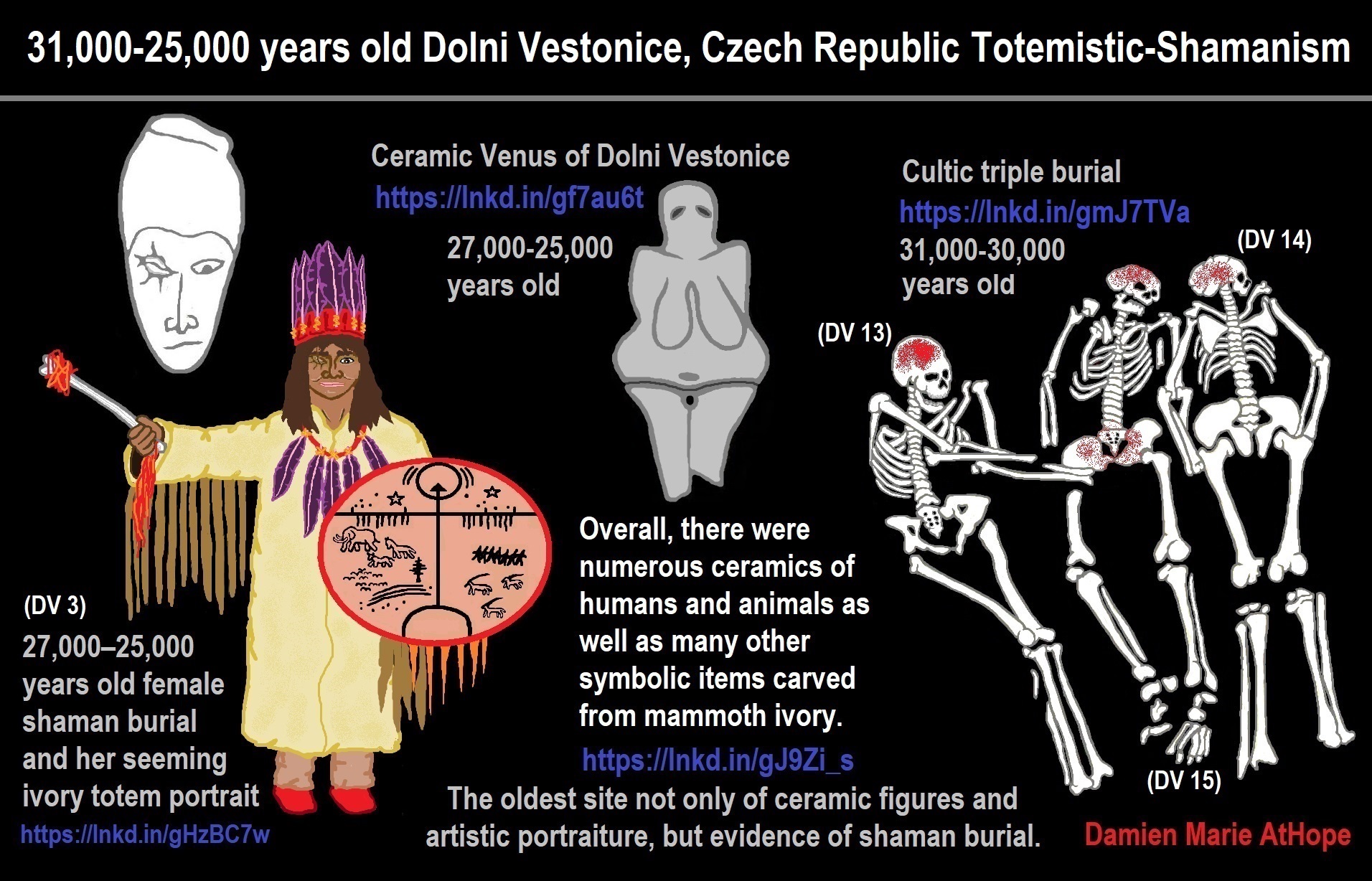
ref, ref, ref, ref, ref, ref, ref, ref, ref, ref, ref
31,000-25,000 Dolni Vestonice, Czech Republic Totemistic-Shamanism
“A remarkable cluster of Pavlovian radiocarbon dates is recorded during the following two millenia, between 27 – 25 ky (Jöris & Weninger 2004). These dates were received from Willendorf II (layers 6-8), Aggsbach, Krems, Grub/Kranawetberg, Dolní Vestonice – Pavlov, Milovice (settlement), Borsice, Jarosov (settlement), Spytihnev, and Predmostí (the main occupation layer). An increase of microliths, including the geometric microliths (lunates, triangles, trapezes), is typical at this stage, especially within the Dolní Vestonice – Pavlov area (fig. 3). A variety of pointed blades and microblades continue to occur, but the typical leaf-points are absent at this stage. A few of the 14 C datings from sites like Dolní Vestonice, Milovice and Jarosov are later than 25 ky; so, for example, the mammoth bone deposits at Milovice and Jarosov are dated later than the related settlements. If these dates are correct, they would suggest a prolongation of occupation at these sites after the Pavlovian.” ref
“The most typical example of another type of Early Gravettian, non-Pavlovian site, is Bodrogkeresztúr-Henye in eastern Hungary (Dobosi, ed. 2000). The site provided two dates, 28.7 ± 3 ky and 26.3 ± 0.4 ky that place it chronologically to the Early Gravettian. Contrary to the Pavlovian sites, however, the fauna is dominated by horse and elk, and the lithic industry, dominated by burins, retouched blades, endscrapers and sidescrapers, lacks the typical microliths. In addition, there are differences of rather functional nature. Nemsová, a workshop site with an Early Gravettian date in western Slovakia, is located near an important raw material source: the radiolarite. Two smaller cave sites, Slaninova Cave and Dzeravá skala Cave, yielded early Gravettian dates in association with fragments of the typical ivory points with circular section. This may be an evidence for periodical visits of Gravettian hunters in the karstic regions.” ref

31,000-25,000 years old Dolni Vestonice, Czech Republic Totemistic-Shamanism
“This Shaman hails from a place now called Dolni Vestonici, earning her the glamorous name “Dolni Vestonici 3” as the third burial found at the site. So I’ll call her Devee, the DV3 burial1. Devee did take a major blow to the face but she recovered, the resulting disfigurement and Devee’s continued survival, despite this injury, is a key piece of evidence she was important to her tribe. Of course, she’d still need help from her friends to recover in the first place.” ref
“Red powdery and crusty concentrations from the fill-up and bottom of a female burial DV3 from the Dolní Věstonice I site, representing Pavlovian culture. The burial floor and fill-up is composed of marly substrate mixed with bone powder, charcoal ash and red, rounded, relatively hard particles, composed of burnt iron bearing aluminosilicates. Red crusts, present on it (maybe also within it), applied probably as suspension, are composed of unburnt iron bearing aluminosilicates. The raw material for powders is assumed to come from the site hearths red ash. Red iron artifacts, macroscopically almost identical, occur on the site also as an assemblage of loose red lumps. They are petrographically inhomogeneous and their sources are localized up to 94 miles away from the site. Raw material similar to the one of some of red lumps may have been used for burial ceremony. The red ferruginous materials may have been exploited in areas of particular importance, away from hunting and flint (and other raw materials) trails.” ref
“The DV3 burial was found in the cultural layer of the first settlement object. The grave pit was dug into the Pleistocene marly silt mixed with limestone debris. The sediment was formed as a result of solifluxion of the nearby Tertiary sediments. Grave pit with the flexed body of a middle aged woman was covered by red coloring agent, greyish marly fill-up and two mammoth scapulae contacting tightly one with the other. They are covered by a compacted layer of calcareous debris with an ash and “dye.” This layer was present only in the burial pit and in the immediate vicinity of it. The upper part of the skeleton, especially the skull was covered with red material. Colouring continued in the vicinity of isolated bones. A woman’s body, probably was smeared with marly soil with immersed red powder. Staining was visible also under the temporal bone. Perhaps, after the decomposition of soft body parts the red particles infiltrated to bone surfaces tinting them. Numerous red ferruginous pieces and lumps were present out of the DV3 grave. Points at the local sources (up to 1 km from the site) of red raw materials, e.g. Mn-Fe concretions from the Ždanice Middle Oligocene flysch, limonite concretions from Eocene sediments near Milovice and goethite from the vicinity of the Pavlovske Hills.” ref
“Nevertheless, geology of the area in some dozen kilometers is much more complex and numerous other rocks may have been sources of red iron oxides, including, among others, terra rosa of unknown (but probably Eocene) age, variegated shales from Oligocene-Miocene and Paleocen-Middle Eocene flysh, red claystones (Ždanice-Hustopeče Formation), Cretaceous spongolite at the Dyje river, Inner Carpathian pyrite-pyrhotine with their red weathering crusts, neohercynian hematite veins and stockwerks (also along the Vah valley), red continental Lower Permian sediments and Visean flysh (culm) facies with variegated shales. In 150 km radius Považsky Inovec and Jeseníky Mts. metamorphosed Devonian sedimentary-volcanogenic rocks of Lahn-Dill type were also available for Pavlovian societies. On the one hand there is interest in the diversity of petrographic origin and processing of red raw ferruginous red lumps found on the site beyond the grave DV3. On the other hand, there is questions about the nature of red microartifacts associated with a sepulchral context: what is their composition and origin? Were they intentionally processed? Is there one or more varieties of sediments in the burial? Do the red powders of burial sediment (or sediments) have any relationship with red lumps from beyond the grave, or they are specific in origin and processing? Could they be a deliberately burnt raw material?” ref
The Upper Paleolithic triple burial of Dolní Vestonice: pathology and funerary behavior.
“The Gravettian triple burial of young individuals at Dolní Vestonice includes a skeleton in the middle (DV 15) is pathological and very problematic to sex though first believed to be a female, currently thought to be a slender male; the other two (DV 13 and DV 14) are somewhat larger males and lie in an unusual position. The pathological condition of the (DV 15) skeleton in the middle include asymmetric shortening of the right femur and of left forearm bones, bowing of the right femur, right humerus, and left radius, elongation of fibulae, dysplasias of the vertebral column, and very marked enamel hypoplasias suggesting chondrodysplasia calcificans punctata (CCP) complicated by trauma and early fractures of the upper limbs leaving permanent deformities on affected bones.” ref
“Among the different forms of CCP, the X-linked dominant form is that resulting in asymmetric shortening and is lethal during early infancy in males. Thus, survival of DV 15 until young adult age would require the specimen to be a female. Clinical findings often associated with the disease (erythemas, ichthyosis, alopecia, cataracts, and joint contractures, among others) would emphasize the singular aspect of this individual, pointing to a condition that should be carefully taken into account when speculating on the significance of that peculiar burial.” ref
“Excavations at Dolní Věstonice II unearthed a structured settlement with a single male burial DV 16 and a number of stone and bone tools, decorative objects, as well as fragmented remains of associated human individuals making it one of the most important sites of the Central European Gravettian.” ref, ref
“Dolní Věstonice I site, belongs to an assemblage of the Pavlovian sites (Early Gravettian) of the Southern Moravia (Czech Republic), together with the Dolní Věstonice II and III, Pavlov I-VI, Milovice I and IV and the Middle Moravia Basin sites. Dolní Věstonice I as well as other Southern Moravian sites were located at the foothill of Pavlovske Vrchy, close (0.3 miles) from the Dyje river.” ref
“The Dolní Věstonice – Pavlov cultural areas are similar in many ways to the Kostenki – Borshevo region beside the Don River in Russia. It was not just one site, it was many, spread over a fairly wide area, and was an open air site. Most open air sites do not give the wealth of data that these sites, both here at Dolní Věstonice and at Kostenki, have yielded, and both are from similar times. Both have Venus figures, both depended heavily on mammoths for their culture, and both used mammoth bones in the creation of shelters.” ref
“In the Vestonice 13 sample, the Y chromosomal haplogroup CT (not IJK-L16) (CTS109+, CTS5318+, CTS6327+, CTS8243+, CTS9556+, Z17718+, Y1571+, M5831+) was determined, for the Vestonice 15 sample, the Y chromosome haplogroup BT (PF1178+), in the Vestonice 43 sample, the Y chromosome haplogroup F (not I) (P145+, P158+). In the Vestonice 16 sample, the Y chromosomal haplogroup C1a2 (V20+, V86+).” ref
“None of the Sungir individuals were found to be closely related even though the SII to SIV individuals buried together share both mitochondrial and Y chromosome lineages. We then inferred genomic segments that were identical by descent and homozygous by descent from three higher-coverage Sungir genomes (Sungir 2 to Sungir 4) and a panel of ancient and contemporary humans. The distributions of homozygous by descent tracts were different between early anatomically modern humans and archaic humans, indicating small effective population sizes and/or recent inbreeding in archaic individuals, particularly the Altai Neandertal.” ref
“Only some of the Sungir individuals were interred with a rich material culture, including spears made of mammoth ivory, ivory beads and perforated fox teeth and red ochre, The remains material culture and lithic evidence, and the presence of ochre, a links them to a wider complex of human burials from Russia to Portugal. There is seeming late or final stage of ‘Streletskian’ lithic culture evidence, which is speculated to be an outgrowth of the Mousterian, similar to the Châtelperronian, an industry with elements of both the Mousterian and the Aurignacian, and is contemporaneous with the Aurignacian.” ref, ref, ref, ref
“The ‘Streletskian’ lithic culture found at Sungir is associated with and sometimes referred to as the Kostenki-Streletsk culture.” ref
“The European Mousterian culture is the product of Neanderthals. It existed roughly from around 160,000-40,000 years ago, around when Neanderthals started the Châtelperronian culture (around 44,500 – 36,000 years ago) and besides a possible relation to the Modern human Aurignacian culture it is speculated that the due to things like the use of ivory at Châtelperronian sites which appear to be more frequent than that of the later Aurignacian may relate to the origins of the very similar Gravettian culture as well as other features found in the Szeletian culture. As well as associated primarily with the earliest anatomically modern humans in West Asia and North Africa likely learned from Neanderthals.” ref, ref, ref, ref
“Certain forms of bifacial points, numerous series of side-scrapers, and predominance of flakes in the manufacture of tools are the basis to include Sungir to the group of Streletskian sites. The characteristics of stone inventory, on the basis of which Sungir can be attributed to the Streletskian, at the same time, allow us to compare this site with final Szeletian of Central Europe. Now this conclusion is not refuted by the presence of Aurignacian types, because the same pattern is seen in some Szeletian sites of Central Europe. Moreover, a few sites were excavated in Eastern Europe in the last decades, toolkit of which is similar to streletskian and at the same time contains Aurignacian types. It is primarily the site of Garchi I, located in the North-East of European part of Russia, and the site of Vys, located in the Central part of Ukraine.” ref
“The Szeletian culture seemingly seen at generally dates to around 38 000 – 28 000 years ago and was widespread from largely Hungary, Czechoslovakia, and southwestern Poland. However, its influence can also be seen at a number of places in Romania and Bulgaria. The Szeletian culture developed mainly from the local Mousterian culture and for a time was contemporaneous with the Aurignacian culture. It was succeeded by the Gravettian cultures.” ref
“Sungir is thought to be a late stage of the Streletskian and characterized by a greater proportion of blades and fewer ‘leaf-points’, with more burins than at other sites. Russian colleagues place the site in a transitional phase related to the previous early Upper Palaeolithic (EUP).” ref
“The ‘Streletskian’ lithic culture found at Sungir is associated with and sometimes referred to as the Kostenki-Streletsk culture.” ref
“Streletskian points’ are documented in several assemblages from the Kostёnki complex of Upper Palaeolithic sites in south-western Russia. Some of these assemblages have been argued to evidence very early modern human occupation of Eastern Europe. However, Streletskian points are also recorded from younger contexts, notably at Kostёnki 11, where examples are attributed both to Layer V and the stratigraphically higher Layer III. The apparent relatively young age of Layer III has led some to view it as the latest manifestation of the Streletskian, although its assemblage has also been compared to the non-Streletskian Layer I of Kostёnki 8, with the two described together as the Anosovka-Tel’manskaya Culture. There is a 28,500–27,000 cal years ago date for a wolf burial associated with Layer III of Kostёnki 11 confirm the layer as younger than other Streletskian assemblages at Kostёnki. New radiocarbon dates for Kostёnki 8 Layer I show that the two layers are broadly contemporary, and that both are close in age to assemblages of Kostёnki’s (Late Gravettian) Kostёnki-Avdeevo Culture.” ref
“The origin of Gravettian is seen as a more complex process than was thought before, involving an impact of industries with backed blades and bladelets from the eastern Mediterranean (Ahmarian, Lagaman, Dabba, beginning before 40 ky BP). After its establishment in Europe, the Danubian Gravettian is ordered into earlier Pavlovian stage (30-25 ky BP), concentrated in the Austrian-Moravian-South Polish corridor, and later Willendorf-Kostenkian stage (25-20 ky BP), widely dispersed over central and eastern Europe. The Epigravettian, termed Kasovian (after 20 ky BP), should be clearly separated from the earlier Gravettian stock.” ref
“The Gravettian, as the most complex Upper Paleolithic cultural entity in the Danubian Europe. Such as, the Gravettian sites in Lower Austria, on the Danube or Moravia, at Dolní Vestonice and Predmostí and Middle Moravia Basin. Others such as Pavlov VI, Bohemia, Silesia, Slovakia, and Hungary. Specifically, sites of the Danubian Gravettian provided a relatively large series of modern human fossil remains, such as, the spectacular finds of newborn babies, ritually buried at Krems-Wachtberg. As well as the sites of Dolní Vestonice – Pavlov and Predmosti.” ref
“A wolf burial being associated with Layer III of Kostёnki 11 demonstrate its association with the chronological group IV, hence confirming its recent age relative to Kostёnki-Borshchëvo’s Spitsynian, Aurignacian, Early Gravettian, and Gorodtsovian sites and layers. The dates are instead similar to new dates for Kostёnki 8 Layer I, with which the Kostёnki 11 Layer III lithic assemblage, which have previously been grouped as the ‘Anosovka-Tel’manskaya Culture’. These two assemblages are also chronologically close to Late Gravettian Kostёnki-Avdeevo Culture sites such as Kostёnki 1 Layer I and Kostёnki 18. A new study of the Kostёnki 11 Layer III lithic assemblage would enable meaningful comparison with Kostёnki 8 Layer I, and assessment of blade production at all of these sites should help to elucidate the relationships between them. A single Streletskian point from Layer III at Kostёnki 11 has previously been used to propose a cultural link with Streletskian sites and assemblages at Kostёnki and beyond.” ref
“However, there is reason to question the association of this Streletskian point with other lithic material from Layer III. Stratigraphic uncertainties relating to Layer III remain unresolved, including those in the test-pit that yielded the Streletskian point. There is also currently no technological context for the Streletskian point in the remainder of the Kostёnki 11 Layer III lithic assemblage. The blank from which it was made is unusual for the layer, the secondary thinning technique used for its manufacture is not evident on any of the layer’s other artifacts, and no characteristic thinning flakes have been found, despite their presence at other Streletskian sites at Kostënki.” ref
Kostenki – Offers Evidence for Early Human Migrations into Europe
“The occupations at Kostenki include several Late Early Upper Paleolithic levels, dated between 42,000 to 30,000 calibrated years ago (cal BP). Kostenki is located in the Pokrovsky Valley of Russia, on the west bank of the Don River, about 400 kilometers (250 miles) south of Moscow and 40 km (25 mi) south of the city of Voronezh, Russia.” ref
- Cover layer: several stacked occupations dated to the Eastern Gravettian (such as Kostenki 1 at 29,000 years ago and Epi-Gravettian from Kostenki 11 at 14,000-19,000 years ago)
- Upper layer: several stacked occupations, early and mid-Upper Paleolithic, including Initial Upper Paleolithic, Aurignacian, Gravettian, and local Gorodsovian
- Whitish layer: volcanic ash dated 39,300 years ago.
- Lower layer: several stacked horizons, early and mid-Upper Paleolithic, including Initial Upper Paleolithic, Aurignacian, Gravettian, and local Gorodsovian. ref
“Moreover, Excavators at Kostenki (Anikovich et al.) reported that they had identified occupation levels within and below the ash level. They found the remnants of the Early Upper Paleolithic culture called the “Aurignacian Dufour,” numerous small bladelets quite similar to lithic tools found in similarly dated sites in western Europe. Prior to Kostenki, the Aurignacian sequence was considered the oldest component associated with modern humans at archaeological sites in Europe, underlain by Mousterian-like deposits representing Neanderthals. At Kostenki, a sophisticated tool kit of prismatic blades, burins, bone antler, and ivory artifacts, and small perforated shell ornaments lies below the CI Tephra and Aurignacian Dufour assemblage: these were identified as an earlier presence of modern humans in Eurasia than previously recognized.” ref
“There was found a genetic relationships between Kostenki-14 (Markina Gora) who died more than 36,000 years ago and Neanderthals–more evidence that early modern humans and Neanderthals interbred–as well as genetic connections to the Mal’ta individual from Siberia and European Neolithic farmers. Further, they found a fairly distant relationship to Australo-Melanesian or eastern Asian populations.” ref
“Moreover, DNA recovered from a 36,000 year old fossil skeleton found in Russia shows early divergence of Eurasians once they had left Africa, and the deep shared ancestry of Europeans. The new study, carried out by an international team of researchers, also reveals when Neanderthals and early modern humans out of Africa interbred – around 54,000 years ago, before the modern human population began to differentiate. The Kostenki 14 genome shows that once people had dispersed beyond the African homeland into Eurasia, they separated early – before 36,000 years ago – into at least three populations whose descendants would develop the unique features that reflect the core of the diversity of non-African peoples. What we can see from Kostenki and other ancient genomes is that for 30,000 years there was a single meta-population in Europe. These Palaeolithic hunter-gatherer groups split up, mixed, dispersed and changed, and through ancient genomes we can trace the genetic thread of their shared ancestry. For example, the genome reveals that the people from Kostenki contributed genes to the ancestors of the boy from Mal’ta, who lived in Siberia 26,000 years ago, and whose descendants spread as far as Europe and the Americas.” ref

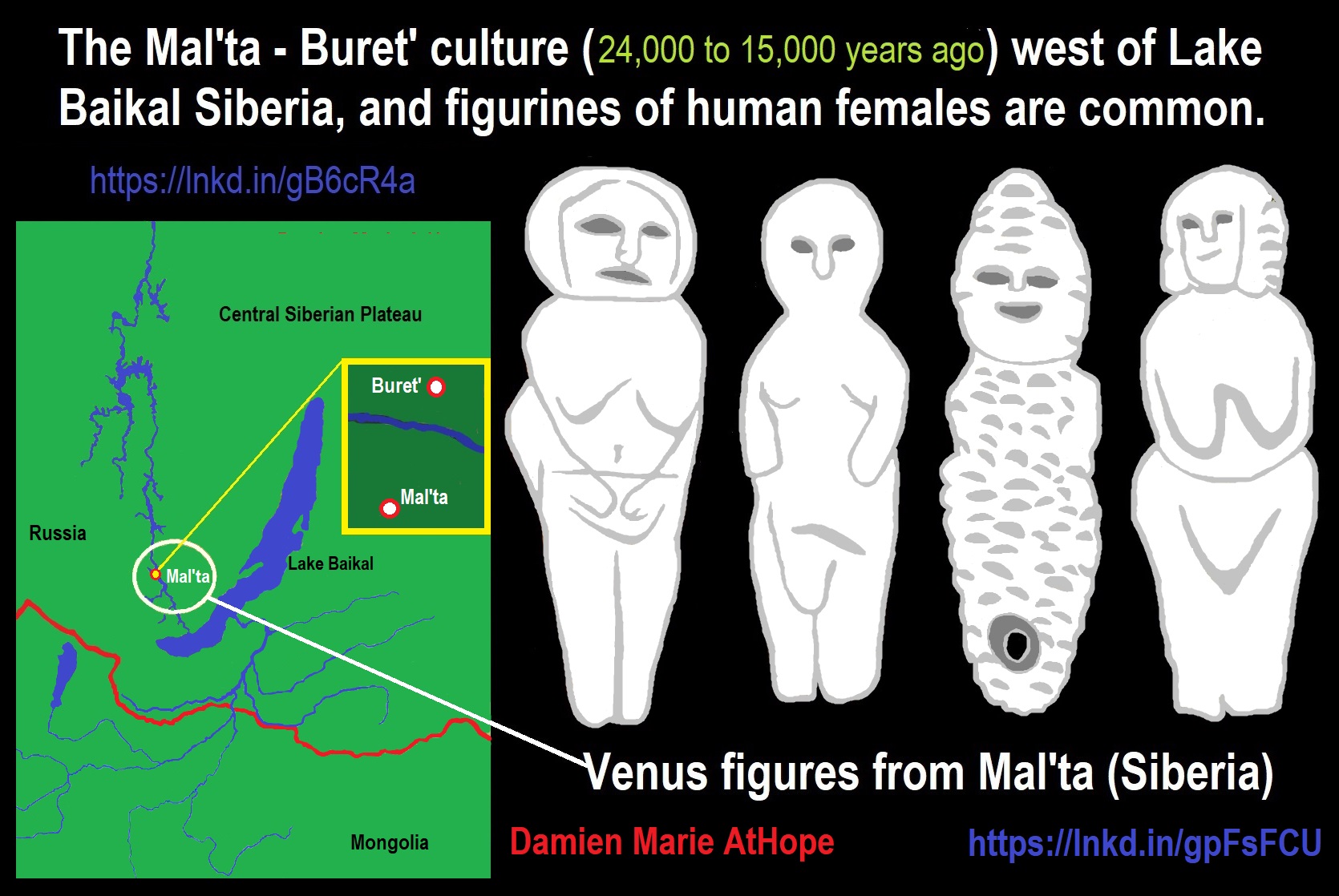
Mal’ta–Buret’ culture of Siberia and Basal Haplogroup R* or R-M207
A preference for the pathological?
“The isolated Sungir remains (Sungir 4 and 5) display little evidence of pathological abnormality, other than minor trauma and periodontal degeneration in Sungir 5. Sungir 1 exhibits a suite of dental and osteoarthritic degenerations, a minor cranial shape irregularity and the upper thoracic (T1) incision that caused his immediate death. Only the last lesion is notable for an approximately 40-year-old Mid Upper Palaeolithic human. The Sungir 2 and 3 remains, however, exhibit suites of pathological abnormalities, those affecting the latter skeleton being the more obvious. These developmental changes, with unknown soft tissue and physiological consequences, have led to suggestions that individuals with noticeable pathological conditions were treated differently in death in the Upper Palaeolithic. Indeed, in the Mid Upper Palaeolithic, individuals with marked developmental or degenerative abnormalities are relatively common in the burial record, accounting for a third of the sufficiently well-preserved individuals. These include Barma Grande 2, Brno 2, Cro-Magnon 1, Dolní Věstonice 3, 15 and 16, Mal’ta 1, Pataud 1 and Sungir 1–3. The Pleistocene fossil record in general has an elevated frequency of such pathological individuals, few of whom were buried prior to the Upper Palaeolithic. The abundance of pathological remains poses the question as to whether the high frequency in Mid Upper Palaeolithic burials is due to mortuary behavior or to the stresses of a Pleistocene foraging existence. It can, nonetheless, be queried whether the greater burial elaboration of grave 2 vs grave 1 was related to the abnormalities of Sungir 2 and 3 and the consequences for their behavior before death.” ref
Multiple burials?
Sungir grave 2 is notable for being double and head to head (rather than side by side). Mid Upper Palaeolithic multiple burials are, however, moderately common. Of the 38 graves, 4 are double and 2 are triple (not counting the Krems-Wachtberg neonatal twins). The head-to-head, rather than side-by-side, position of the individuals in grave 2 is unusual, but it may have been used to accommodate the long ivory spears.” ref
Attention to the immature?
“The elaboration of grave 2 suggests that these individuals had a certain status ascribed to them, something beyond that which they could have acquired during only a decade of life. Yet, the Arene Candide 1 adolescent had the next most elaborate Mid Upper Palaeolithic burial, and the Borsuka, Krems-Wachtberg and Mal’ta infants were accorded an abundance of ochre, beads and/or jeweler. Although Mid Upper Palaeolithic burials are biased towards mature individuals (59 per cent, n = 49, expected: approximately 42 per cent), these young individuals were provided with the same range of body decoration in death; it is probable that they also exhibited extensive decoration when alive.” ref
The isolated human remains?
“The presence of the isolated Sungir 7 element in the Cultural Layer poses a question as to why this individual was treated differently when other individuals received variably elaborate disposals. Although the human bone may have been moved by cryoclastic processes, the remains did not derive from the known burials. Did the individual die at a time when burial was not possible, or was the body simply abandoned on the surface, with only this element being preserved? At other Mid Upper Palaeolithic sites with elaborate burials, isolated human remains are moderately common; they were present at Dolní Věstonice I and II, Kostenki, Krems-Wachtberg, Miesslingtal, Paglicci, Pavlov I, Předmostí and at other sites without burials. They generally lack carnivore damage, but are variably weathered and broken.” ref
Disposal of the dead at Sungir
“The mortuary behavior evident at Sungir indicates considerable diversity in their treatment at an individual level. Four of the individuals were intentionally buried, two of them had their remains manipulated and one of them seems to have received little or no formal treatment. Yet each of these forms and levels of mortuary behavior is evident at other Mid Upper Palaeolithic sites. The Dolní Věstonice/Pavlov site-complex exhibits all three forms of disposal. Several other sites reveal two of these patterns, while two burials (Arene Candide 1 and Brno 2) approach the complexity of grave 2. Most of the individual features from the three Sungir burials are apparent in other Mid Upper Palaeolithic burials. These shared aspects include single vs multiple burials, ochre, beads (whether of ivory, tooth, stone or shell) in variable quantities, rare art objects and the presence of skeletal abnormalities. The unusual aspects are the amount of personal decoration, the ivory spears and the Sungir 4 femur.” ref
“The most elaborate burial, in terms of arrangement, personal decoration and the inclusion of unusual and art objects, is grave 2. In particular, the ivory spears stand out in a Mid Upper Palaeolithic context, as their inclusion reflects disposal (or formal destruction) of utilitarian, rather than strictly aesthetic, objects. This is followed by grave 2bis, which has evidence for decoration plus two unusual artifacts. Grave 1 is simple by comparison, containing only items of personal decoration. Although the burial is notable for the abundance of beads and arm bands, the suddenness of Sungir 1’s death and the association of the beads with clothing suggest that the personal decoration was not death-related. Therefore, the burials at Sungir exhibit noticeable diversity; only the abundance of beads unite them as a group, and that should reflect social behavior in life, rather than in death.” ref
“This diversity in death at Sungir also raises long-standing questions regarding social differentiation in the Mid Upper Palaeolithic. Given that mortuary behavior should reflect the social statuses of both the living and the dead, it is tempting to ascribe elevated status to those with more elaborate burials. Yet the Mid Upper Palaeolithic burials do not differ significantly in terms of males vs females (21 vs 13), or in the degree of elaboration by sex (e.g. Brno 2 male vs Ostuni 1 female). Differential social status may apply to Sungir 2 and 3 and the other elaborately buried Mid Upper Palaeolithic children, as their young ages would preclude attaining acquired status. It may also concern the cases of special treatment of body portions, such as Sungir 4 and 5, and the apparent lack of treatment for individuals whose remains ended up scattered in cultural debris. Some of the latter can be attributed to post-depositional processes, but the others are probably due to the abandonment of bodies. The perimortem processes would need to be assessed biologically, culturally and taphonomically on a case-by-case basis.” ref
“Overall, the diverse patterns of disposal of the dead at Sungir are generally similar to the mortuary practices evident in other Mid Upper Palaeolithic sites. The Sungir mortuary patterns are unusual only in some of the offerings in grave 2 and the quantity of personal decoration. In this context, they are not exceptional, just spectacular. They also show considerable variation between individuals, despite the impression given by graves 1 and 2. One can only speculate as to whether the manners of their deaths (known only for Sungir 1, but probably related to abnormalities affecting Sungir 2 and 3) influenced their final burial contexts. The differential disposal of the dead at Sungir is, however, sufficient to reflect a complex diversity of mortuary behavior among these Late Pleistocene foragers. Most importantly, it reflects a diversity of social behaviors in terms of social identities and social considerations. The Sungir remains, both biological and cultural, herald the establishment and the subsequent elaboration of these patterns among Late Pleistocene foragers.” ref
Here are some scholarly articles could be interesting to explain ancient moviments of various haplogroup:
Pleniglacial steppes of the great plain of Eastern Europe:
Mezinian landscape system (Late Upper Palaeolithic of Eastern Europe).
http://www.sciencedirect.com/science/article/pii/S1040618215006473
Continuity of human occupations within the Eastern European plain, with the persistence of hunting methods and the relative diversity of animal exploitation, during the Upper Pleniglacial. These sites are really important for the understanding of cultural processes in the Eastern European Upper Palaeolithic, and particularly for the understanding of Epigravettian origin: New evidences about human activities during the first part of the Upper Pleniglacial in Ukraine from zooarchaeological studies
http://www.sciencedirect.com/science/article/pii/S1040618215014299
The last glacial maximum in Western, Central, and Eastern Europe, where, despite typological differences in assemblages, common characteristics may be highlighted:
Territories and economies of hunter–gatherer groups during the last glacial maximum in Europe.
http://www.sciencedirect.com/science/article/pii/S1040618215006588
East adriatic: A long hard road… Reviewing the evidence for environmental change and population history in the eastern Adriatic and western Balkans during the Late Pleistocene and Early Holocene. http://www.sciencedirect.com/science/article/pii/S1040618216311788
World’s oldest pottery: Human behavioral responses to environmental condition and the emergence of the world’s oldest pottery in East and Northeast Asia: An overview.
http://www.sciencedirect.com/science/article/pii/S1040618216306139
Siberia: Early pottery in Transbaikal Siberia: New data from Krasnaya Gorka.
http://www.sciencedirect.com/science/article/pii/S104061821630430X
Czech Republic (“Pavlovian”) and Croatia: Palaeolithic ceramic technology: The artistic origins and impacts of a technological innovation.
http://www.sciencedirect.com/science/article/pii/S1040618216303500
18 and 17 ka cal. BP. albania: After the cold: Epigravettian hunter-gatherers in Blazi Cave (Albania). http://www.sciencedirect.com/science/article/pii/S1040618216302919
UKRAINIAN UPPER PALAEOLITHIC BETWEEN 40/10.000 BP: CURRENT INSIGHTS INTO ENVIRONMENTAL-CLIMATIC CHANGE AND CULTURAL DEVELOPMENT. https://www.researchgate.net/publication/326998252_UKRAINIAN_UPPER_PALAEOLITHIC_BETWEEN_4010000_BP_CURRENT_INSIGHTS_INTO_ENVIRONMENTAL-CLIMATIC_CHANGE_AND_CULTURAL_DEVELOPMENT
Greece: local human population growth over the course of the Paleolithic in greece. New data from a nearby site, Kephalari Cave, augment this hypothesis: Climate change, human population growth, or both? Upper Paleolithic subsistence shifts in southern Greece
http://www.sciencedirect.com/science/article/pii/S1040618215002414
Not east euurope but west(possibility of arrive h1 mtdna from north africa? Mesolithic hunter-gatherers stone-working tecniques in North Africa and Western Europe. This article proposes a new exploration of this shift, which is the most important during the Mesolithic in Europe, based on the interrogation of a database of 570 sites, using very strict ordering criteria. The examination of the first occurrences of these industries region by region reveals a diffusionist process that seems to begin in North Africa (Tunisia) at the end of the 8th or the very beginning of the 7th millennium cal. BC, before spreading progressively towards the Atlantic Ocean: Why this revolution? Explaining the major technical shift in Southwestern Europe during the 7th millennium cal. BC
http://www.sciencedirect.com/science/article/pii/S1040618215007545
Caucasus: The environment in the Caucasus in the Upper Paleolithic (Late Pleistocene): Evidence from the small mammals from Dzudzuana cave, Georgia
http://www.sciencedirect.com/science/article/pii/S1040618216300283
Baikal siberia: Ecosystem analysis of Baikal Siberia using Palaeolithic faunal assemblages to reconstruct MIS 3 – MIS 2 environments and climate
http://www.sciencedirect.com/science/article/pii/S1040618216300702
East-west europe demography: extinction of the local population in western Central Europe around 22,000 years ago. Demographic estimates of hunter–gatherers during the Last Glacial Maximum in Europe against the background of palaeoenvironmental data
http://www.sciencedirect.com/science/article/pii/S1040618216300490
Transbaikal siberia: Emergence of a microlithic complex in the Transbaikal Region of southern Siberia. http://www.sciencedirect.com/science/article/pii/S1040618216300593
New finds of Upper Palaeolithic decorative objects from Predmost ı, Czech Republic. https://www.researchgate.net/publication/273293266_New_finds_of_Upper_Palaeolithic_decorative_objects_from_Predmosti_Czech_Republic
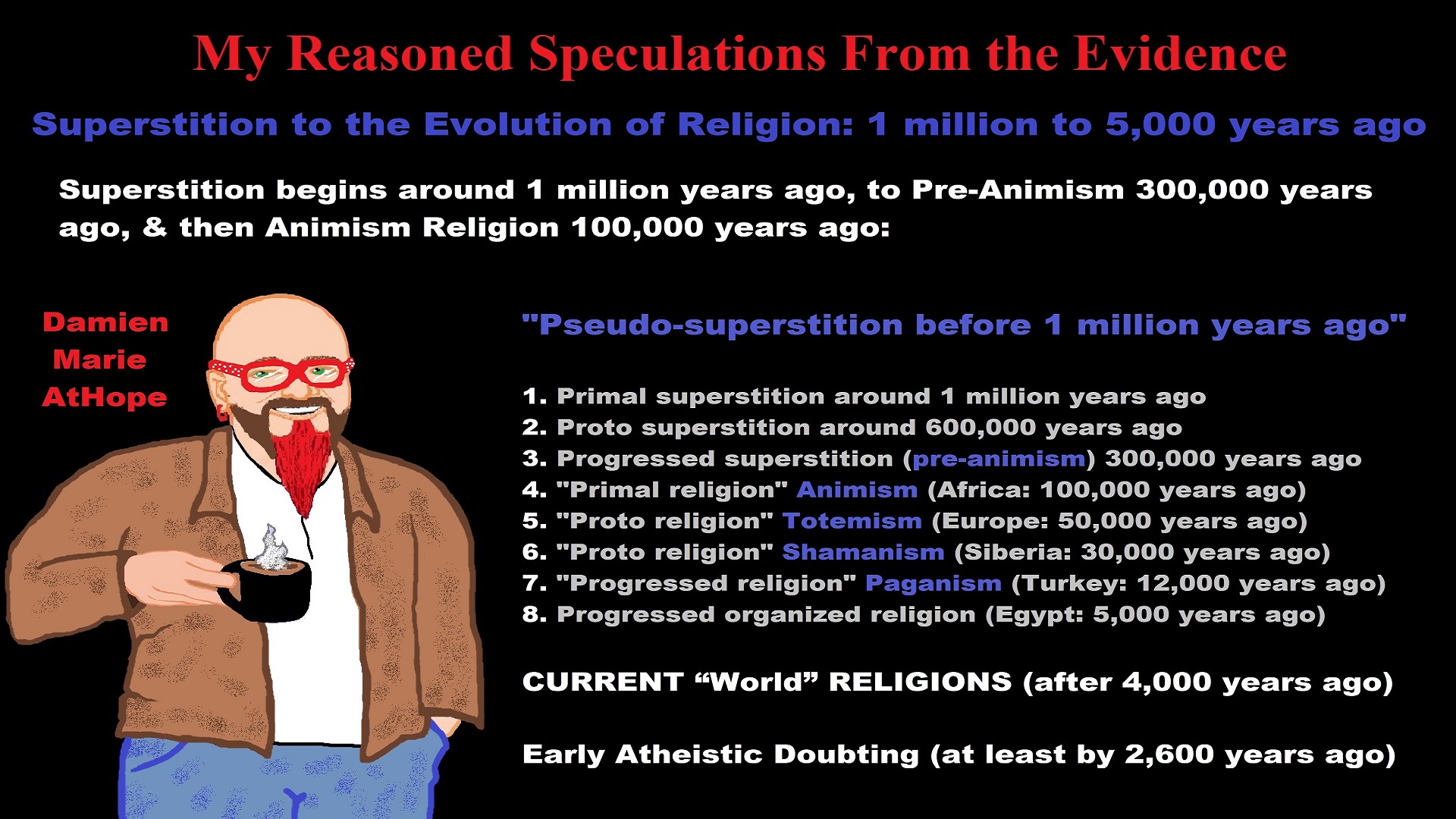


While hallucinogens are associated with shamanism, it is alcohol that is associated with paganism.
The Atheist-Humanist-Leftist Revolutionaries Shows in the prehistory series:
Show two: Pre-animism 300,000 years old and animism 100,000 years old: related to “Anarchism and Socialism”
Show tree: Totemism 50,000 years old: related to “Anarchism and Socialism”
Show four: Shamanism 30,000 years old: related to “Anarchism and Socialism”
Show five: Paganism 12,000 years old: related to “Anarchism and Socialism”
Show six: Emergence of hierarchy, sexism, slavery, and the new male god dominance: Paganism 7,000-5,000 years old: related to “Anarchism and Socialism” (Capitalism) (World War 0) Elite and their slaves!
Prehistory: related to “Anarchism and Socialism” the division of labor, power, rights, and recourses: VIDEO
Pre-animism 300,000 years old and animism 100,000 years old: related to “Anarchism and Socialism”: VIDEO
Totemism 50,000 years old: related to “Anarchism and Socialism”: VIDEO
Shamanism 30,000 years old: related to “Anarchism and Socialism”: VIDEO
Paganism 12,000 years old: related to “Anarchism and Socialism” (Pre-Capitalism): VIDEO
Paganism 7,000-5,000 years old: related to “Anarchism and Socialism” (Capitalism) (World War 0) Elite and their slaves: VIEDO
Paganism 5,000 years old: progressed organized religion and the state: related to “Anarchism and Socialism” (Kings and the Rise of the State): VIEDO
Paganism 4,000 years old: related to “Anarchism and Socialism” (First Moralistic gods, then the Origin time of Monotheism): VIEDO
I do not hate simply because I challenge and expose myths or lies any more than others being thought of as loving simply because of the protection and hiding from challenge their favored myths or lies.
The truth is best championed in the sunlight of challenge.
An archaeologist once said to me “Damien religion and culture are very different”
My response, So are you saying that was always that way, such as would you say Native Americans’ cultures are separate from their religions? And do you think it always was the way you believe?
I had said that religion was a cultural product. That is still how I see it and there are other archaeologists that think close to me as well. Gods too are the myths of cultures that did not understand science or the world around them, seeing magic/supernatural everywhere.
I personally think there is a goddess and not enough evidence to support a male god at Çatalhöyük but if there was both a male and female god and goddess then I know the kind of gods they were like Proto-Indo-European mythology.
This series idea was addressed in, Anarchist Teaching as Free Public Education or Free Education in the Public: VIDEO
Our 12 video series: Organized Oppression: Mesopotamian State Force and the Politics of power (9,000-4,000 years ago), is adapted from: The Complete and Concise History of the Sumerians and Early Bronze Age Mesopotamia (7000-2000 BC): https://www.youtube.com/watch?v=szFjxmY7jQA by “History with Cy“
Show #1: Mesopotamian State Force and the Politics of Power (Samarra, Halaf, Ubaid)
Show #2: Mesopotamian State Force and the Politics of Power (Eridu “Tell Abu Shahrain”)
Show #3: Mesopotamian State Force and the Politics of Power (Uruk and the First Cities)
Show #4: Mesopotamian State Force and the Politics of Power (First Kings)
Show #5: Mesopotamian State Force and the Politics of Power (Early Dynastic Period)
Show #6: Mesopotamian State Force and the Politics of Power (King/Ruler Lugalzagesi)
Show #7: Mesopotamian State Force and the Politics of Power (Sargon and Akkadian Rule)
Show #9: Mesopotamian State Force and the Politics of Power (Gudea of Lagash and Utu-hegal)
Show #12: Mesopotamian State Force and the Politics of Power (Aftermath and Legacy of Sumer)

The “Atheist-Humanist-Leftist Revolutionaries”
Cory Johnston ☭ Ⓐ Atheist Leftist @Skepticallefty & I (Damien Marie AtHope) @AthopeMarie (my YouTube & related blog) are working jointly in atheist, antitheist, antireligionist, antifascist, anarchist, socialist, and humanist endeavors in our videos together, generally, every other Saturday.
Why Does Power Bring Responsibility?
Think, how often is it the powerless that start wars, oppress others, or commit genocide? So, I guess the question is to us all, to ask, how can power not carry responsibility in a humanity concept? I know I see the deep ethical responsibility that if there is power their must be a humanistic responsibility of ethical and empathic stewardship of that power. Will I be brave enough to be kind? Will I possess enough courage to be compassionate? Will my valor reach its height of empathy? I as everyone, earns our justified respect by our actions, that are good, ethical, just, protecting, and kind. Do I have enough self-respect to put my love for humanity’s flushing, over being brought down by some of its bad actors? May we all be the ones doing good actions in the world, to help human flourishing.
I create the world I want to live in, striving for flourishing. Which is not a place but a positive potential involvement and promotion; a life of humanist goal precision. To master oneself, also means mastering positive prosocial behaviors needed for human flourishing. I may have lost a god myth as an atheist, but I am happy to tell you, my friend, it is exactly because of that, leaving the mental terrorizer, god belief, that I truly regained my connected ethical as well as kind humanity.
Cory and I will talk about prehistory and theism, addressing the relevance to atheism, anarchism, and socialism.
At the same time as the rise of the male god, 7,000 years ago, there was also the very time there was the rise of violence, war, and clans to kingdoms, then empires, then states. It is all connected back to 7,000 years ago, and it moved across the world.
Cory Johnston: https://damienmarieathope.com/2021/04/cory-johnston-mind-of-a-skeptical-leftist/?v=32aec8db952d
The Mind of a Skeptical Leftist (YouTube)
Cory Johnston: Mind of a Skeptical Leftist @Skepticallefty
The Mind of a Skeptical Leftist By Cory Johnston: “Promoting critical thinking, social justice, and left-wing politics by covering current events and talking to a variety of people. Cory Johnston has been thoughtfully talking to people and attempting to promote critical thinking, social justice, and left-wing politics.” http://anchor.fm/skepticalleft
Cory needs our support. We rise by helping each other.
Cory Johnston ☭ Ⓐ @Skepticallefty Evidence-based atheist leftist (he/him) Producer, host, and co-host of 4 podcasts @skeptarchy @skpoliticspod and @AthopeMarie
Damien Marie AtHope (“At Hope”) Axiological Atheist, Anti-theist, Anti-religionist, Secular Humanist. Rationalist, Writer, Artist, Poet, Philosopher, Advocate, Activist, Psychology, and Armchair Archaeology/Anthropology/Historian.
Damien is interested in: Freedom, Liberty, Justice, Equality, Ethics, Humanism, Science, Atheism, Antiteism, Antireligionism, Ignosticism, Left-Libertarianism, Anarchism, Socialism, Mutualism, Axiology, Metaphysics, LGBTQI, Philosophy, Advocacy, Activism, Mental Health, Psychology, Archaeology, Social Work, Sexual Rights, Marriage Rights, Woman’s Rights, Gender Rights, Child Rights, Secular Rights, Race Equality, Ageism/Disability Equality, Etc. And a far-leftist, “Anarcho-Humanist.”
I am not a good fit in the atheist movement that is mostly pro-capitalist, I am anti-capitalist. Mostly pro-skeptic, I am a rationalist not valuing skepticism. Mostly pro-agnostic, I am anti-agnostic. Mostly limited to anti-Abrahamic religions, I am an anti-religionist.
To me, the “male god” seems to have either emerged or become prominent around 7,000 years ago, whereas the now favored monotheism “male god” is more like 4,000 years ago or so. To me, the “female goddess” seems to have either emerged or become prominent around 11,000-10,000 years ago or so, losing the majority of its once prominence around 2,000 years ago due largely to the now favored monotheism “male god” that grow in prominence after 4,000 years ago or so.
My Thought on the Evolution of Gods?
Animal protector deities from old totems/spirit animal beliefs come first to me, 13,000/12,000 years ago, then women as deities 11,000/10,000 years ago, then male gods around 7,000/8,000 years ago. Moralistic gods around 5,000/4,000 years ago, and monotheistic gods around 4,000/3,000 years ago.


Damien Marie AtHope (Said as “At” “Hope”)/(Autodidact Polymath but not good at math):
Axiological Atheist, Anti-theist, Anti-religionist, Secular Humanist, Rationalist, Writer, Artist, Jeweler, Poet, “autodidact” Philosopher, schooled in Psychology, and “autodidact” Armchair Archaeology/Anthropology/Pre-Historian (Knowledgeable in the range of: 1 million to 5,000/4,000 years ago). I am an anarchist socialist politically. Reasons for or Types of Atheism
My Website, My Blog, & Short-writing or Quotes, My YouTube, Twitter: @AthopeMarie, and My Email: damien.marie.athope@gmail.com

